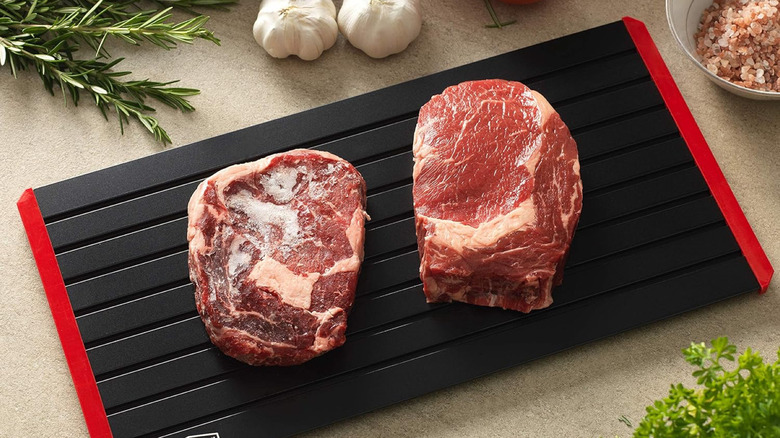How Defrosting Pans Work And What You Should Never Thaw On Them
Cooking takes time. In addition to the minutes needed to cook the dish over heat, there's also the time needed to prepare the ingredients, and that includes thawing the meat. The goal is to ensure the protein is evenly thawed and safe for cooking without committing mistakes that can be avoided when defrosting meat. Of course, there's a right way to thaw frozen food, but not everyone has the luxury of time to thaw frozen meat in the fridge for 12 hours. And while microwaving is the fastest way to melt the liquid in frozen meat, it does not guarantee even thawing all the time.
Enter defrosting pans, also known as defrosting boards or trays. These flat metal boards are supposedly designed to cut the time it takes to defrost frozen food. The tray is made of either a copper or aluminum sheet with silicone coating. How this works is up to the laws of thermodynamics, particularly how heat is transferred between two objects with different temperatures.
Since a defrosting pan is made of heat-conducting metal, it transfers the warmer temperature of the kitchen to the meat that is being thawed on its surface. At the same time, the colder temperature in the meat is transferred to the tray. As a result, the frozen meat thaws faster than when left on the counter without the defrosting pan or placed in the fridge. Essentially, this means that f you're in a hurry, you don't need to throw frozen burger patties on the grill anymore, because thawing trays can hasten the defrosting process for you.
What meats should never be thawed on defrosting pans?
Using a defrosting pan when cooking frozen steak can be handy. However, there are a few caveats that you should always bear in mind. While you can thaw steak and any other type of frozen meat using the heat-conducting board, you also need to first consider the thickness of the meat. A thick cut would most certainly require a longer waiting period before it can be ready for cooking. Yes, most defrosting pans advertise themselves as being capable of thawing frozen food in an hour or less. But what many fail to recognize is that this is still subjective and based on the food's thickness.
The reason why you should never thaw thick cuts of frozen meat on a defrosting tray is because it could lead to food safety issues. As the meat stays longer on the tray, disease-causing bacteria and toxins that can cause food poisoning will start to proliferate at room temperature. This explains why the USDA Food Safety and Inspection Service recommends thawing meat, poultry, and seafood inside the fridge, where they will remain in a cold environment (40 degrees Fahrenheit and below) that inhibits rapid bacterial growth. Additionally, food thawed in the fridge can still be refrozen if you decide not to cook it right away.
Is a defrosting pan worth buying?
With cheap options retailing for as low as $7.99, it's understandable if you would jump the gun and buy one for your kitchen. Just be informed that so far, reviews from different sources have been mixed. The Food Network's Rachel Trujillo noticed that while the tray she tested lived up to its word of defrosting salmon and chicken in an hour or less, it took an hour and a half to completely thaw steak. She recommended flipping the meat every 30 minutes to ensure even thawing. In the end, she was satisfied with the defrosting pan's performance, and also noted how easy it was to clean and store.
On the other hand, The Kitchn's Rochelle Bilow had a different experience. After thawing two frozen boneless chicken breasts that were wrapped in plastic, she discovered that an hour on a defrosting pan was not enough. The meat slices were still 75% frozen after an hour, prompting her to transfer them to the fridge to finish thawing. This prompted her to raise concern about the tray, noting the risk of the food entering the "danger zone" when left standing for hours. Bilow's resolve: The tray may be worth buying for fish fillets and smaller meat cuts, but it's not a necessity in the kitchen.


